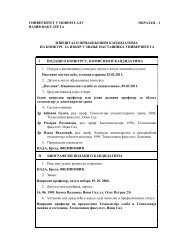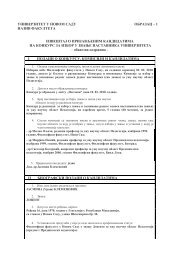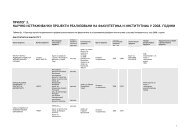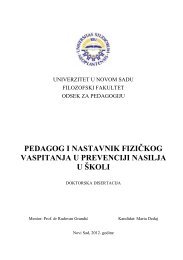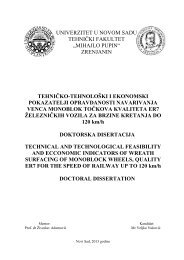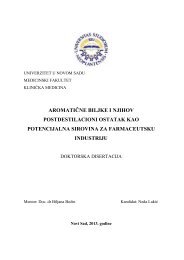Intercultural competence as an aspect of the communicative ...
Intercultural competence as an aspect of the communicative ...
Intercultural competence as an aspect of the communicative ...
You also want an ePaper? Increase the reach of your titles
YUMPU automatically turns print PDFs into web optimized ePapers that Google loves.
[…] (e.g. x culture values <strong>the</strong> elderly)’ (ibid) which, while on one h<strong>an</strong>d instils <strong>the</strong> sense <strong>of</strong><br />
belonging, on <strong>the</strong> o<strong>the</strong>r h<strong>an</strong>d contr<strong>as</strong>ts <strong>the</strong> experience <strong>of</strong> one culture to that <strong>of</strong> o<strong>the</strong>rs.<br />
Summarizing different definitions with functional elements, Faulkner et al. (2006) point<br />
that in this view, culture is a design for life, a tool to org<strong>an</strong>ize collective life <strong>an</strong>d to deal<br />
with everyday problems. It is <strong>the</strong>n tr<strong>an</strong>smitted to o<strong>the</strong>r members, including immigr<strong>an</strong>ts, <strong>as</strong><br />
this design reduces <strong>the</strong> number <strong>of</strong> interpretations <strong>of</strong> ide<strong>as</strong>, individuals, <strong>an</strong>d events <strong>an</strong>d<br />
thus helps org<strong>an</strong>ize <strong>the</strong> world. However, it is such simplified framework that causes<br />
intercultural misunderst<strong>an</strong>dings.<br />
Finally, in <strong>the</strong> cognitive approach <strong>the</strong> me<strong>an</strong>s <strong>of</strong> org<strong>an</strong>ising <strong>the</strong> experience are not<br />
something observable, ra<strong>the</strong>r, ‘culture is a computer programme, with <strong>the</strong> programme<br />
differing from culture to culture’ (Lochtm<strong>an</strong>, Kappel 2010: 13), similarly to how<br />
H<strong>of</strong>stede characterized culture – <strong>as</strong> a programming <strong>of</strong> <strong>the</strong> mind (H<strong>of</strong>stede 1997). While<br />
agreeing that behaviourist <strong>an</strong>d functional approaches c<strong>an</strong> help students better underst<strong>an</strong>d<br />
a foreign culture <strong>an</strong>d predict some cultural behaviour <strong>an</strong>d also heighten <strong>the</strong>ir awareness <strong>of</strong><br />
o<strong>the</strong>r culture, <strong>an</strong>thropologists believe that <strong>the</strong>se approaches rely too much on empiricism<br />
which might prevent, ra<strong>the</strong>r th<strong>an</strong> promote, underst<strong>an</strong>ding. The view is that not everything<br />
that is present in a culture <strong>an</strong>d globally shared is observable.<br />
For Goodenough (1964), who is one <strong>of</strong> <strong>the</strong> main representatives <strong>of</strong> cognitive<br />
<strong>the</strong>ories <strong>of</strong> culture (influenced by structural linguistic), culture is not static in its nature<br />
<strong>an</strong>d it is not only comprised <strong>of</strong> ‘things, people, behavior, or emotions’ (p 36).<br />
Goodenough sees culture <strong>as</strong> a combination <strong>of</strong> all <strong>the</strong>se things – <strong>the</strong> ‘model <strong>of</strong> perceiving,<br />
relating, <strong>an</strong>d o<strong>the</strong>rwise interpreting’ (p. 36) things, people, behaviours, emotions. An<br />
import<strong>an</strong>t view here is that culture is represented <strong>as</strong> a guiding <strong>an</strong>d monitoring <strong>as</strong>pect <strong>of</strong><br />
relationships between individuals, what h<strong>as</strong> been named ‘<strong>the</strong> socially tr<strong>an</strong>smitted<br />
information’ (Cronk 1999: 12 in Faulkner et al. 2006: 34).<br />
In more recent cognitive <strong>the</strong>ories <strong>of</strong> culture, knowledge is still seen <strong>as</strong> <strong>the</strong> most<br />
import<strong>an</strong>t element, since individuals need to possess it ‘in order to act <strong>as</strong> <strong>the</strong>y do, make<br />
<strong>the</strong> things <strong>the</strong>y make, interpret <strong>the</strong>ir experiences in <strong>the</strong> distinctive way <strong>the</strong>y do’ (Holl<strong>an</strong>d,<br />
Quinn 1987: 4).<br />
The criticism against cognitive <strong>the</strong>ories <strong>of</strong> culture is aimed at <strong>the</strong>ir too narrow a<br />
focus on internal mental processes <strong>an</strong>d separation <strong>of</strong> <strong>the</strong>m from external interactions. The<br />
more recent <strong>the</strong>ories are <strong>the</strong>refore taking into account relationship between those internal<br />
processes <strong>an</strong>d me<strong>an</strong>ings that are shared in a society. Ano<strong>the</strong>r criticism is that cognitive<br />
<strong>the</strong>ories present a static image <strong>of</strong> culture. Some ch<strong>an</strong>ges have been made in regard to this<br />
20



